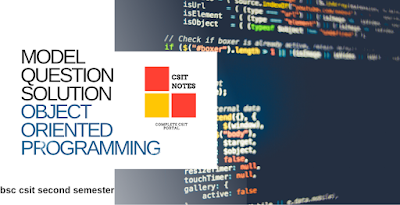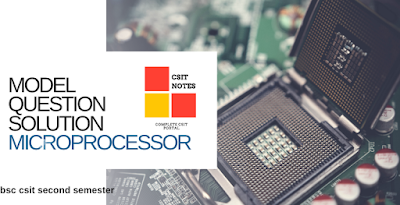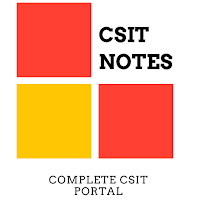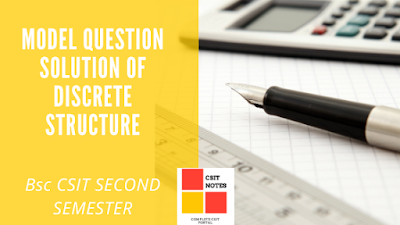NEWS
Pageviews
Saturday, November 9, 2019
Thursday, November 7, 2019
Design and Analysis of Algorithms |bsccsit Notes | 5th Semester
Design and Analysis of Algorithms |bsccsit Notes | 5th Semester
Source:http://bsccsitblog.blogspot.com/
Wednesday, November 6, 2019
Simulation And Modeling |bsccsit 5th semester notes |csit-notes
Simulation And Modeling
|bsccsit 5th semester notes |
bsccsit notes Simulation and Modeling
Download Simulation Note By Nipun Thapa
Sunday, November 3, 2019
bsccsit Syllabus - Semester V
CSIT Syllabus - Semester V
bsccsit
 |
| B.Sc CSIT Syllabus - Semester V |
Design and Analysis of Algorithms
Design and Analysis of Algorithms
CSC314
Theory + Lab
Course Description: This course introduces basic elements of the design and analysis of computer algorithms. Topics include asymptotic notations and analysis, divide and conquer strategy, greedy methods, dynamic programming, basic graph algorithms, NP-completeness, and approximation algorithms. For each topic, beside in-depth coverage, one or more representative problems and their algorithms shall be discussed.
Course Objectives:
• Analyze the asymptotic performance of algorithms.
• Demonstrate a familiarity with major algorithm design techniques
• Apply important algorithmic design paradigms and methods of analysis.
• Solve simple to moderately difficult algorithmic problems arising in applications.
• Able to demonstrate the hardness of simple NP-complete problems
Course Contents:
Unit 1: Foundation of Algorithm Analysis (4)
1.1. Algorithm and its properties, RAM model, Time and Space Complexity, detailed analysis of algorithms (Like factorial algorithm), Concept of Aggregate Analysis
1.2. Asymptotic Notations: Big-O, Big-Ω and Big-Ө Notations their Geometrical Interpretation and Examples.
1.3. Recurrences: Recursive Algorithms and Recurrence Relations, Solving Recurrences (Recursion Tree Method, Substitution Method, Application of Masters Theorem)
Unit 2: Iterative Algorithms (4)
2.1. Basic Algorithms: Algorithm for GCD, Fibonacci Number and analysis of their time and space complexity
2.2. Searching Algorithms: Sequential Search and its analysis
2.3. Sorting Algorithms: Bubble, Selection, and Insertion Sort and their Analysis
Unit 3: Divide and Conquer Algorithms (8)
3.1. Searching Algorithms: Binary Search, Min-Max Finding and their Analysis
3.2. Sorting Algorithms: Merge Sort and Analysis, Quick Sort and Analysis (Best Case, Worst Case and Average Case), Heap Sort (Heapify, Build Heap and Heap Sort Algorithms and their Analysis), Randomized Quick sort and its Analysis
3.3. Order Statistics: Selection in Expected Linear Time, Selection in Worst Case Linear Time and their Analysis.
Unit 4: Greedy Algorithms (6)
4.1. Optimization Problems and Optimal Solution, Introduction of Greedy Algorithms, Elements of Greedy Strategy.
4.2. Greedy Algorithms: Fractional Knapsack, Job sequencing with Deadlines, Kruskal’s Algorithm, Prims Algorithm, Dijkstra’s Algorithm and their Analysis
4.3. Huffman Coding: Purpose of Huffman Coding, Prefix Codes, Huffman Coding Algorithm and its Analysis
Unit 5: Dynamic Programming (8)
5.1. Greedy Algorithms vs Dynamic Programming, Recursion vs Dynamic Programming, Elements of DP Strategy
5.2. DP Algorithms: Matrix Chain Multiplication, String Editing, Zero-One Knapsack Problem, Floyd Warshwall Algorithm, Travelling Salesman Problem and their Analysis.
5.3. Memoization Strategy, Dynamic Programming vs Memoization
Unit 6: Backtracking (5)
6.1. Concept of Backtracking, Recursion vs Backtracking
6.2. Backtracking Algorithms: Subset-sum Problem, Zero-one Knapsack Problem, N-queen Problem and their Analysis.
Unit 7: Number Theoretic Algorithms (5)
7.1. Number Theoretic Notations, Euclid’s and Extended Euclid’s Algorithms and their Analysis.
7.2. Solving Modular Linear Equations, Chinese Remainder Theorem, Primility Testing: MillerRabin Randomized Primility Test and their Analysis
Unit 8: NP Completeness (5)
8.1. Tractable and Intractable Problems, Concept of Polynomial Time and Super Polynomial Time Complexity
8.2. Complexity Classes: P, NP, NP-Hard and NP-Complete
8.3. NP Complete Problems, NP Completeness and Reducibility, Cooks Theorem, Proofs of NP Completeness (CNF-SAT, Vertex Cover and Subset Sum)
8.4. Approximation Algorithms: Concept, Vertex Cover Problem, Subset Sum Problem
Laboratory Work:
This course can be learnt in effective way only if we give focus is given in practical aspects of algorithms and techniques discussed in class. Therefore student should be able to implement the algorithms and analyze their behavior. Students should:
• Implement comparison sorting algorithms and perform their empirical analysis.
• Implement divide-and-conquer sorting algorithms and perform their empirical analysis.
• Implement algorithms for order statistics and perform their empirical analysis. Implement algorithms by using Greedy, DP and backtracking paradigm Implement NP-complete problems and realize their hardness.
Recommended Books:
1. Thomas H. Cormen, Charles E. Leiserson, Ronald L. Rivest and Clifford Stein, “Introduction to algorithms”, Third Edition.. The MIT Press, 2009.
2. Ellis Horowitz, Sartaj Sahni, Sanguthevar Rajasekiaran, “Computer Algorithms”, Second Edition, Silicon Press, 2007.
3. Kleinberg, Jon, and Eva Tardos, “ Algorithm Design” , Addison-Wesley, First Edition, 2005
Model question solution of Object Oriented Programming Bsc csit second semester
Model question solution of
Object Oriented Programming
 |
| Bsc csit notes |
Tribhuvan University
Institute of Science and Technology
Course Title: Object Oriented Programming Full Marks: 60
Course No: CSC161 Pass Marks: 24
Level: B. Sc CSIT First Year/ Second Semester Time: 3 Hrs
Section A
Long Answer Questions
Attempt any two questions. [2*10=20]
1. What is object oriented programming? Explain objects, class, encapsulation, data hiding, inheritance, and polymorphism.
2. Explain operator overloading. Write a program that overloads insertion and extraction operators.
3. What is inheritance? Explain the ambiguities associated with multiple inheritance with suitable example programs.
Section B
Short Answer Questions
Attempt any eight questions. [8*5=40]
4. Explain the purpose of a namespace with suitable example.
5. What is the principle reason for passing arguments by reference? Explain with suitable code.
6. Why constructor is needed? Explain different types of constructors with example.
7. Write a program that illustrates the conversions between objects of different classes having conversion function in source object.
8. Explain the difference between private and public inheritance with suitable diagram.
9. Why friend function is required? Discuss with example.
10. How late binding is different from early binding. Write a program that explains late binding using virtual function.
11. Why do we need exceptions? Explain “exceptions with arguments” with suitable program.
12. What are the advantages of using the stream classes for I/O? Write a program that writes object to a file.
Friday, November 1, 2019
Model Question solution of Microprocessor BSc. CSIT Second Semester
Model Question solution of Microprocessor BSc. CSIT Second Semester
 |
| model question solution of Microprocessor |
Model Question
Bachelor Level/ First Year/ Second Semester/ Science Full Marks: 60
Microprocessor (CSC 162) Pass Marks: 24
Time: 3 hours.
Candidates are required to give their answers in their own words as for as practicable.
The figures in the margin indicate full marks.
Group A (Long Answer Question Section)
Attempt any TWO questions. (2x10=20)
1. Draw logical block diagram of 8086 microprocessor and explain its segmented memory structure.
2. What is machine cycle and instruction cycle? Draw a timing diagram for STA 2000h memory instruction. (Choose any memory locations for loading STA 2000h instruction)
3. Write an assembly language program to sort an array in ascending order using 8 bit microprocessor. (Assume appropriate array data and address where minimum array size of 10 should be considered)
Group B (Short Answer Question Section)
Attempt any EIGHT questions. (8x5=40)
4. Draw pin diagram of 8085 microprocessor with appropriate labelling.
5. Specify the output in PORT1 after the execution of the following program. Write comments for each instruction.
MVI A, AAH
MOV B, A
RRC
XRA B
OUT PORT1
HLT
6. What is DMA? Explain the sequence of events that occurs during DMA operation?
7. What is addressing mode? Explain different addressing mode in 8085 microprocessor.
8. Write a program to reverse a given a string using 16 bit microprocessor.
9. Explain memory interfacing in 8085 microprocessor along with appropriate diagram.
10. What are different operating modes in 80286 microprocessor? Explain in brief about each mode.
11. “Interrupt based I/O is efficient compared to polled I/O”. Justify this statement with general working mechanism in both methods.
12. Write Short Notes (Any Two):
a) Macro Assembler
b) BSR Mode
c) System Bus
MODEL QUESTION SOLUTION OF DISCRETE STRUCTURE second semester Bsc csit
Model question solution ofdiscrete structure
Section A
Long Answer Questions
Attempt any 2 questions. [2*10=20]
1. Why breaking down of large integer into set of small integers is preferred while performing integer arithmetic? Find sum of numbers 123,684 and 413,456 by representing the numbers as 4-tuple by using reminders modulo of pair-wise relatively prime numbers less than 100. {2+8}
2. Define linear homogeneous recurrence relation. Solve the recurrence relation an=an/2+n+1, with a1=1.Also discuss about probabilistic primility testing with example. {2+4+4}
3. How Zero-one matrix and diagraphs can be used to represent a relation? Explain the process of identifying whether the graph is reflexive, symmetric, or anti-symmetric by using matrix or diagraph with suitable example. {4+6}
Section B
Short Answer Questions
Attempt any 8 questions. [8*5=40]
4. Prove that 𝐴∩𝐵 =𝐴∪𝐵 by using set builder notation. How sets are represented by using bit string? Why it is preferred over unordered representation of sets? {3+2}
5. How can you relate domain and co-domain of functions with functions in programming language? Discuss composite and inverse of function with suitable examples. {2+3}
6. State Euclidean and extended Euclidean theorem. Write down extended Euclidean algorithm and illustrate it with example. {1+4}
7. State and prove generalized pigeonhole principle? How many cards should be selected from a deck of 52 cards to guarantee at least three cards of same suit? {2.5+ 2.5}
8. Represent the argument “If it does not rain or if is not foggy then the sailing race will be held and the lifesaving demonstration will go on. If sailing race is held then trophy will be awarded. The trophy was not awarded. Therefore it not rained” in propositional logic and prove the conclusion by using rules of inferences. {2+3}
9. Discuss common mistakes in proof briefly. Show that n is even if n3+5 is odd by using indirect proof. {2+3}
10. How mathematical induction differs from strong induction? Prove that 12+22+32+⋯…….𝑛2=𝑛 𝑛+1 (2𝑛+1)/6 by using strong induction. {1+4}
11. Write down recursive algorithm for computing an. Argue that your algorithm is correct by using induction. {2.5+2.5}
12. What is meant by chromatic number? How can you use graph coloring to schedule exams? Justify by using 10 subjects assuming that the pairs {(1,2), (1,5), (1,8), (2,4), (2,9), (2,7), (3,6), (3,7), (3,10), (4,8), (4,3), (4,10), (5,6), (5,7)} of subjects have common students. {1+4}























